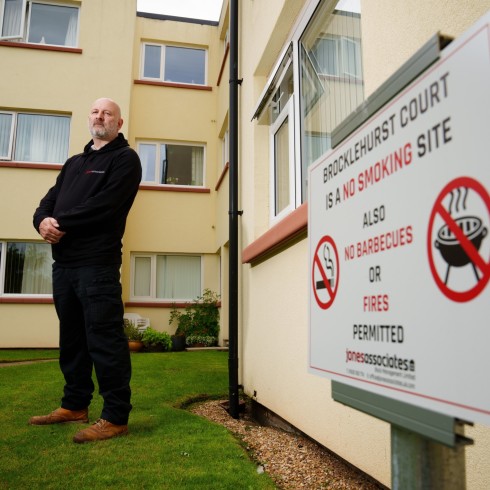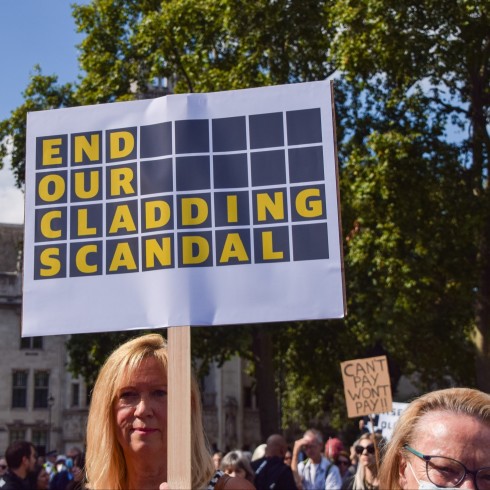‘Arbitrary’ cladding rules leave residents in England’s low-rises with big bills
Thousands of leaseholders in low-rise blocks of flats in England are facing large bills to replace cladding and correct other fire-safety defects after being excluded from legislation that capped the amount residents have to contribute to remedial works six years after the Grenfell fire disaster.
Campaign group End Our Cladding Scandal has raised concerns with officials at the housing department on behalf of leaseholders in about 100 apartment blocks below 11m who face paying out for fire safety work, with some demands running into tens of thousands of pounds each.
The 2017 Grenfell fire triggered a building safety crisis affecting millions of residents in tower blocks across the country. An inquiry into the fire is ongoing but initially concluded that cladding was the “principal reason why the flames spread so rapidly”.
This has led to costly remedial works on many high rises, including the replacement of suspect flammable cladding and other measures, such as installing fire breaks and new alarm systems.
But apartment buildings below 11m in height, deemed as lower risk by the government, are not covered by legislation aimed at protecting residents from having to pay for replacing cladding, which includes pursuing developers for compensation. The rules also cap the cost of wider fire-safety work at £15,000 in London and £10,000 elsewhere.
Moreover, freeholders are allowed to pass building costs on to leaseholders, resulting in a number of recent court rulings rejecting attempts to make landlords share in the cladding bill.
In some cases seen by campaigners, these costs have been picked up by residents after their buildings failed fire safety assessments. In others, insurers have made cover contingent on remedial work being carried out even if the cladding was deemed a low threat to life because they consider it has a higher fire risk than other materials.

At one three-storey development, Brocklehurst Court in Macclesfield, leaseholders said insurer Axa, which had taken over the policy via an acquisition, had said it would only continue coverage on the basis that cladding be removed and other measures.
Residents pushed back, arguing the polystyrene-based cladding was suitable for a building of this height, and said it would cost them about £23,000 each to replace.
The cladding was not put on by the original developer and was instead installed under a government green scheme a decade ago. “This stuff would not be on if the government had not put it on,” said Julian Jones of Jones Associates, a property management company which is working with the Brocklehurst residents.
Axa said the leaseholders had offered it a timescale for remediation, which it accepted and became part of the renewal conditions. “Remediation is the only long-term solution to address the risk that has led to high premiums,” said David Ovenden, chief underwriting officer for commercial at Axa UK, stressing that the insurer had “not left any of our existing customers without insurance cover”.
Jennifer Frame, a campaigner at End Our Cladding Scandal, said smaller buildings were “no more to blame for the national building safety scandal and the failure of regulation than those in taller buildings”.
She added: “In cases where remediation of defects is essential, it is completely unacceptable for leaseholders to pay anything, let alone tens of thousands of pounds each.”

At Woodchester Court and Hitcham Court in Chipping Barnet, high-pressure laminate cladding, a material with high fire risk, was removed last year, at the cost of £10,000 per flat.
The insurance broker acting for the block informed the residents the insurer Aviva would only cover the building if the cladding was removed, according to Derek Gordon, one of the leaseholders. Replacing it will cost a further £30,000 each but some residents are struggling to afford it. Gordon described the 11m height cut-off point in the legislation as a “totally arbitrary” level.
Aviva said it was unable to comment on specific circumstances, but said in offering to provide cover it would discuss “necessary” remediation works such as to external walls.
It added: “We have taken the same approach to buildings under 11m and since April 2021, unlike many insurers, we have started to offer affordable insurance to new customers.”
End Our Cladding Scandal warned that thousands of leaseholders in small blocks across the country are likely to be facing a large bill for remediation costs.
Frame has urged the government to hold “developers and other responsible parties to account” for fixing defects, and to set up a pilot scheme to approve essential fire safety work for low-rise buildings.
A group of MPs have recently taken up the leaseholders’ cause. In June, 31 parliamentarians called on the government to extend the new leaseholder protections to buildings of all heights and to establish a fund to pay for essential work in residential buildings below 11m.

“So many people are still affected and they are the one group denied any financial assistance whatsoever,” said Labour MP Hilary Benn, who tabled the early day motion calling for a debate in the House of Commons. “It’s simply not good enough and the government must act.”
Former Conservative minister Sir Peter Bottomley, one of the backers, described the 11m rule as “a totally artificial limit”, adding: “Great numbers of leaseholders are stuck with costs they can’t easily afford and in some cases can’t afford at all.”
The government said it would look into any cases where residents were being asked to pay towards remediation work. “Any resident whose landlord or building owner is proposing costly building safety remediation for a building under 11 metres should raise it with us immediately and we will investigate,” it said in a statement.
But it insisted there was no systemic risk in sub-11m buildings and said it was looking to help by “working with the insurance industry to launch a buildings insurance scheme which will aim to reduce premiums for residents in buildings with fire safety issues.”
This story originally appeared on: Financial Times - Author:Ian Smith





























